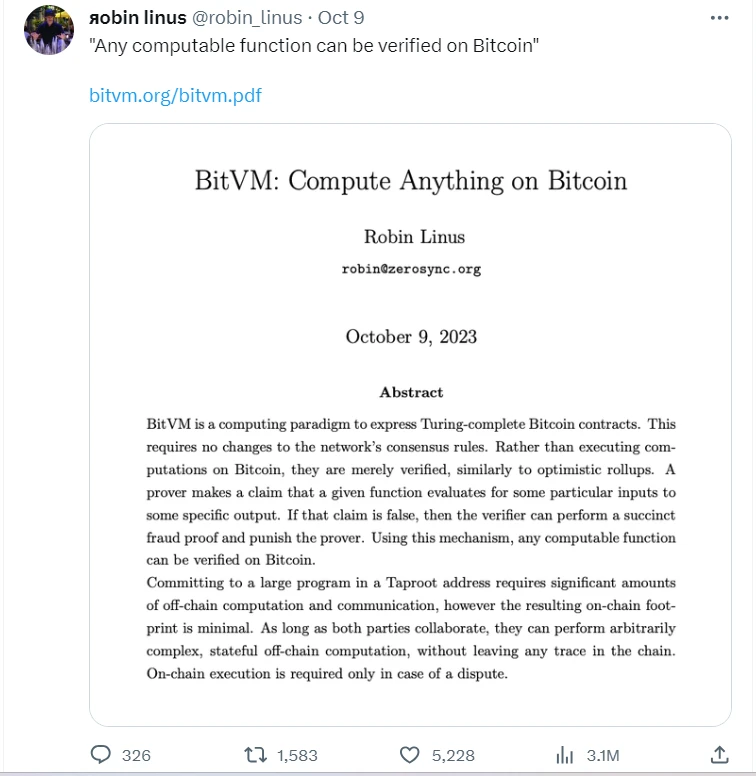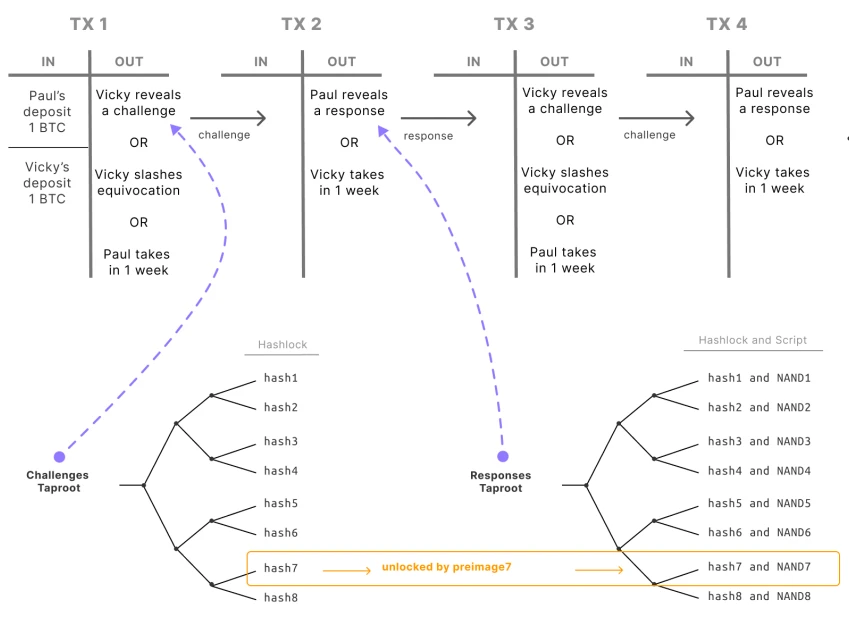Author: Echo, Infinitas
Guidance: Hong Shuning
On October 9th, Robin Linus, co-founder of the blockchain developer ZeroSync, released the white paper for BitVM. "Any computable function can be verified on Bitcoin," Linus posted on X (formerly Twitter) saying. "This makes smart contracts on Bitcoin more expressive. In particular, it implements functionality that we believe requires a soft fork to achieve"—potentially bringing more DeFi use cases and scalability to the network.
BitVM means that Bitcoin can now have Turing completeness like any other chain: allowing developers to run complex contracts on Bitcoin without changing the fundamental rules of Bitcoin. Its emergence enables Bitcoin to compete with smart contract platforms like Ethereum while still maintaining its security and decentralization, sparking heated discussions.

Previously, a series of protocols had emerged for the BTC ecosystem, such as the Ordinals protocol created by Bitcoin Core contributor Casey Rodarmor, which gave birth to the first NFT on the Bitcoin network and introduced the concepts of Ordinals and Inscriptions. Inspired by Peter Todd's proposal of Single-use Seal and Client-Side Validation in 2016, the Taro protocol aims to bring more financial projects to the Bitcoin ecosystem by introducing a new smart contract language that makes Bitcoin more programmable; and the RGB protocol, released version 0.10 this year, treats Bitcoin as the underlying asset and introduces smart contract functionality to the Bitcoin ecosystem.
The emergence of these protocols has brought new possibilities to the development of the Bitcoin ecosystem. They not only increase the functionality and scalability of the Bitcoin network, but also provide more innovative tools for community members to further drive the development of the Bitcoin ecosystem.
What is BitVM?
BitVM stands for "Bitcoin Virtual Machine." We can think of it as a virtual testing laboratory where developers can freely operate any computational program or execute any smart contract, allowing developers to simulate program behavior without imposing any load or changes on the actual Bitcoin network.

By acting as an intermediary layer, BitVM improves efficiency and reduces the computational burden on the Bitcoin blockchain. For complex computations or smart contracts, verification can be done off-chain before irreversible operations are performed. Therefore, this system helps maintain the integrity of the blockchain and provides a platform for more complex yet secure operations. The roles and workflow in BitVM mainly include:
1. Participants: BitVM's operation involves two main participants: the prover and the verifier. The prover initiates the computation or claim, and the verifier is responsible for verifying the claim. Cross-verification by both parties achieves a certain degree of balance, ensuring the accuracy and reliability of the computation results.
2. Off-chain computation: The uniqueness of BitVM lies in its handling of computational workloads. Unlike traditional blockchain operations that place a heavy computational burden on the chain, most of the complex computations in BitVM are executed off-chain. Off-chain computation provides higher speed and flexibility, reducing the amount of data directly stored on the chain.
3. On-chain verification: The only on-chain step required by BitVM is on-chain verification in case of disputes, also known as "fraud proofs." If the verifier questions the legitimacy of the prover's claim, the system will refer to the immutable and decentralized ledger of the Bitcoin chain to resolve the issue. If the prover's claim is proven to be false, the verifier can submit a concise fraud proof to the blockchain, exposing dishonest behavior. By integrating off-chain computation and on-chain verification, a balance between computational efficiency and robust security is achieved.
What is the RGB Protocol?
RGB is a scalable and confidential smart contract system for Bitcoin and the Lightning Network developed by the LNP/BP Standards Association, bringing the complex programmability and flexibility of smart contract platforms like Ethereum into the Bitcoin ecosystem. It adopts the concepts of private and common ownership and is a Turing-complete, trustless distributed computing form that does not require the introduction of non-block decentralized protocols.

The design purpose of RGB is to run scalable, robust, and private smart contracts on UTXO blockchains (such as Bitcoin), allowing digital assets and smart contracts to bring more functionality to Bitcoin. Through RGB, developers can execute actions such as token issuance, NFT minting, DeFi, DAO, and more complex multi-category smart contracts on the powerful blockchain of Bitcoin, continuously stimulating innovation while maintaining its security. The specific execution process includes:
1. RGB asset issuance: Allowing users to create off-chain contracts to issue RGB assets and allocate them to Bitcoin's UTXO, adding RGB assets to Lightning Network off-chain payment channels.
2. Transfers within payment channels: Once added to a payment channel, RGB assets can be transferred and routed between channel participants like Bitcoin Lightning Network payments, completed by transfers verified on the client side.

3. "Fraud proofs": Each time the channel is updated, assets are sent from the channel's multisignature output to the outputs created by the Lightning Network commitment transactions. This means that if an outdated state of the payment channel is broadcast, it may trigger an RGB penalty transaction, taking away all the attacker's RGB assets.
Who is the optimal solution for the next generation narrative in the BTC ecosystem?
Considering the BitVM white paper, BitVM provides the following "new" features for Bitcoin:
1. Ability to implement more complex contracts. Traditional Bitcoin contracts are largely limited to basic operations such as digital signatures and time locks. BitVM provides a wide range of new possibilities for contract creation. Users can build contracts not only for financial transactions but also for more complex decentralized applications (DApps).
2. Reduced need for direct storage of data on the blockchain. Most of the computational work in BitVM is performed off-chain, improving the overall efficiency of the network and preventing unnecessary data from cluttering the blockchain, maintaining the health and speed of the Bitcoin network.
3. Robust fraud protection measures ensure transaction integrity. BitVM uses fraud proof systems and challenge-response protocols to ensure that all transactions are honest and transparent. If someone attempts to cheat or submit false claims, the system's verifiers can quickly capture and expose the dishonest party by submitting concise fraud evidence to the blockchain.
However, in fact, BitVM has unavoidable limitations.
The first limitation is that the design focus on the "two-party setup" of provers and verifiers, meaning the system currently lacks the ability to handle multi-party transactions or contracts, limiting the applicability for multiple participants to engage in more complex interactions. This limitation may hinder BitVM's ability to keep up with emerging demands and expectations.
The second limitation is that the required off-chain data storage and computational load far exceed the capabilities of modern computers. Although off-chain computation helps minimize BitVM's impact on the blockchain, the enormous computational burden makes it practically infeasible, only theoretically feasible.
Concepts such as connecting multiple bidirectional channels to form a network (similar to Bitcoin's Lightning Network) have been considered as methods to expand the system's functionality. It is hoped that the much-anticipated RGB protocol may address the limitations of BitVM in the future.
Comparison of BitVM and RGB
BitVM and the RGB protocol both aim to expand the functionality of Bitcoin, but they have some key differences in design. BitVM emphasizes off-chain computation and fraud protection to ensure the integrity of contract execution and transactions, while RGB focuses more on privacy.
The design of RGB adopts a client-side validation model, meaning that when user A sends assets to user B, user A does not publicly broadcast the transaction on the network, but instead transfers the assets to user B through peer-to-peer transmission. This design only requires the use of the public network to prevent double spending.
• BTC Native Nature: BitVM requires protocol changes to Bitcoin, while RGB can be implemented with a soft fork.
• Complete Privacy Protection: The RGB protocol means that third parties cannot track the history of RGB assets on the blockchain, and only when user B receives the assets will they know the asset's history. BitVM cannot achieve this.
• Commercialization: BitVM has extremely high requirements for computational power, with only theoretical feasibility. In terms of commercial implementation, RGB has the upper hand.
In summary, the BitVM concept is full of innovation and inspiration, but based on its current technical framework, it is likely to be limited to the conceptual stage of the white paper in the short term. The exploration of long-term application scenarios and practical applications still faces significant challenges. In comparison, the RGB protocol has shown a trend of rapid commercialization in large-scale applications and is more mature. Whether both can become the next narrative breakthrough in the Bitcoin ecosystem remains to be seen, and there may also be other protocols emerging, so let's wait and see.
References:
https://www.theblock.co/post/255683/bitvm-bitcoin-smart-contracts
https://blog.bitfinex.com/education/is-bitvm-the-next-evolution-for-smart-contracts-on-bitcoin/
https://www.coindesk.com/tech/2023/10/11/bitcoin-might-get-ethereum-style-smart-contracts-under-bitvm-plan/
https://www.coinonpro.com/baike/157346.html
免责声明:本文章仅代表作者个人观点,不代表本平台的立场和观点。本文章仅供信息分享,不构成对任何人的任何投资建议。用户与作者之间的任何争议,与本平台无关。如网页中刊载的文章或图片涉及侵权,请提供相关的权利证明和身份证明发送邮件到support@aicoin.com,本平台相关工作人员将会进行核查。




